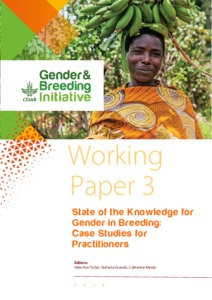State of the Knowledge for Gender in Breeding: Case Studies for Practitioners
Abstract
Debates around gender-responsive agricultural research, particularly plant and animal breeding, invariably circulate around similar topics: the recognition that considering gender is important to developing varieties that lead to equitable benefits, coupled with questions around an evidence base that proves this point. Without convincing evidence—exemplified by case studies across commodities and countries—our arguments for gender-responsive research fall on deaf ears. This synthesis seeks to compile available cases from two workshops organized by the CGIAR Gender and Agriculture Research Network: “Gender, Breeding and Genomics” (18–21 October 2016) and “Innovation in Gender-Responsive Breeding” (5–7 October 2017). While by no means comprehensive, with these 10 cases we hope to emphasize the point that considering gender in breeding program design, working with women in the breeding process, and acting on these findings can have dramatic consequences on breeding programs. We begin the synthesis by setting the scene with a chapter reflecting on how taking gender into account matters for the success of plant or animal breeding programs with welfare or development goals and a focus on smallholders. This chapter illustrates how the use of a conceptual framework for gender analysis can help breeding programs make sense of gender-differentiated traits and tease out the likely impact of taking gender into account in program-level policies and strategies. The following case studies are structured around steps of a plant breeding cycle (see Figure 1.1), examining cases that consider gender in setting breeding priorities, selection, testing experimental varieties, and seed production and distribution. The cases cover a wide range of commodities: beans, cassava, forage grasses, poultry, maize, sorghum, matooke, barley, and groundnuts. Although cases mostly focus on sub-Saharan Africa (Nigeria, Mali, Tanzania, Uganda, Ethiopia, Malawi), we also present cases from China and Syria. What is particularly compelling about these cases is that they not only provide evidence that men and women have different trait preferences; access to resources; or opportunities to engage in production, processing, and marketing of diverse commodities. They also illustrate steps taken by breeding programs to address these issues. These steps range from incorporating “cooking time” as a must-have trait in bean breeding to creating opportunities for maize seed production and sale for women; from changing the structure of matooke breeding programs to add participatory processing for food quality, new breeding targets for adaptation, to nutrient poor soils in sorghum. These are powerful illustrations and positive examples that documenting differences is a means to an end—the real focus should be on change. The synthesis ends with a chapter drawing lessons from the case studies for future action aiming to integrate gender and gender analysis in breeding. We hope that these cases, together with the companion publications from the GBI on design principles1, gender and social targeting2, breeding decisions3, and uptake pathways4, compel and challenge breeding programs to become truly gender responsive

